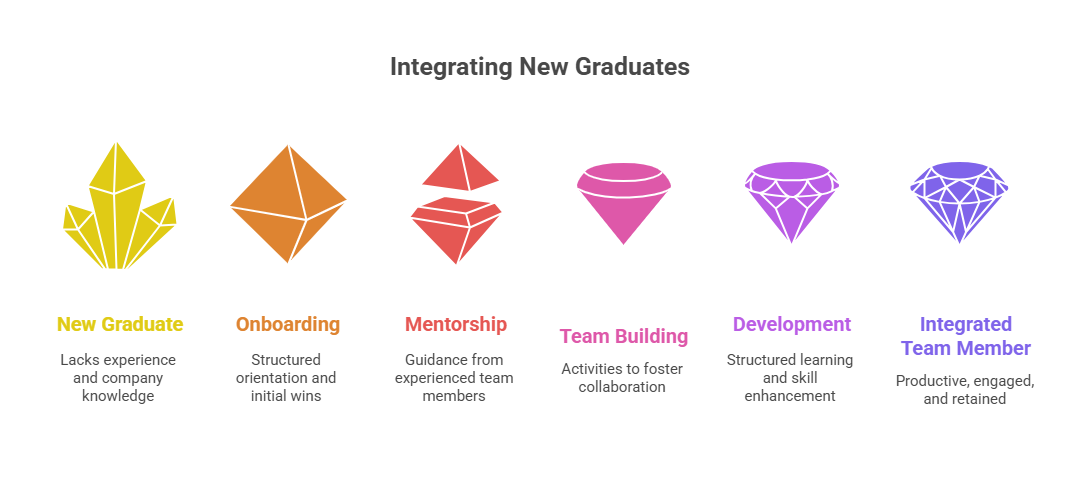
Key Takeaways:
- Graduate integration is essential to unlock energy, digital fluency, and innovation.
- Without structured onboarding, new hires risk disengagement or early turnover.
- The MADANI Graduate Scheme (SGM) shows how allowances, training, and industry exposure boost graduate readiness.
- HR leaders can adapt SGM lessons: structured onboarding, mentorship, and team-building solutions.
- Practical steps include creating clear orientation, assigning mentors, building cross-generational collaboration, and tracking outcomes.
- Team building for graduates should focus on work-relevant collaboration and psychological safety, not just generic icebreakers.
- This article is written for HR departments and HR leaders who want actionable guidance on how to integrate their newly hired graduates within the SGM framework.
Introduction
Every year, thousands of Malaysian graduates step into the workforce for the very first time. While they bring fresh energy, digital fluency, and adaptability, many organisations struggle with one critical challenge: integrating them effectively into existing teams.
Without a structured approach, new hires risk feeling disconnected, which can lead to disengagement or even early turnover. That’s why forward-looking HR managers are investing in stronger onboarding, targeted training, and team-building solutions designed specifically for graduate integration.
This article is intended for HR leaders and departments seeking to go beyond programme awareness. It highlights how insights from the MADANI Graduate Scheme (SGM) can be applied directly to strengthen onboarding practices, improve retention, and help fresh hires transition smoothly into meaningful roles.
What is MADANI Graduate Scheme (SGM)?
The MADANI Graduate Scheme (SGM), or Skim Graduan MADANI, is a government initiative launched by HRD Corp to help Malaysian graduates transition smoothly into the workforce.
It provides financial allowances, structured training, and employer incentives to ensure graduates are not only hired but also equipped with future-ready skills.
The scheme was designed in response to rising graduate unemployment and underemployment, and it aligns with the MADANI framework to strengthen socio-economic development in Malaysia.
By combining industry exposure, structured training, and development pathways, SGM creates opportunities for graduates while giving companies access to skilled young talent.
The key takeaway for HR leaders is not just knowing what SGM is, but understanding how its design can inspire your own onboarding and talent development practices.
HR professionals can view this as more than a policy overview — it serves as a blueprint for creating their own structured onboarding strategies inspired by the programme’s design.
Also read: What is the MADANI Graduate Scheme (SGM)?
Why Graduate Integration with SGM Matters?
Fresh graduates entering the workforce bring energy, digital fluency, and adaptability.
They’re quick learners, often skilled in the latest technologies, and eager to make an impact. But without the right integration, these strengths can easily go untapped.
- Risk of disengagement – Graduates who aren’t properly onboarded may feel disconnected, leading to low morale and eventual turnover.
- Skill-to-role mismatch – Without structured training, there’s often a gap between academic knowledge and workplace application.
- Generational diversity challenges – Today’s workplace includes multiple generations, and without guidance, communication and collaboration barriers can emerge.
- Lost potential for innovation – Fresh graduates can bring new perspectives, but only if they feel confident enough to contribute.
The MADANI Graduate Scheme (SGM) addresses these challenges head-on with structured training, industry exposure, and development pathways.
For HR managers, the scheme shows why graduate integration is not just an HR function but a strategic investment in workplace transformation and long-term talent pipelines.
Lessons From the MADANI Graduate Scheme (SGM)
The MADANI Graduate Scheme offers valuable insights into how organisations can successfully bring new graduates into their workforce. HR managers can adapt these lessons to create smoother, more impactful integration strategies:
- Graduate Development Focus – SGM ensures graduates are not just placed into roles, but supported with structured learning to close the gap between academic theory and workplace practice.
- Structured Training Programmes – By blending classroom learning, on-the-job training, and mentorship, the scheme ensures consistent skill development and faster adaptation to corporate environments.
- Industry Exposure – Graduates are placed in high-demand sectors such as technology, green economy, and digital business, preparing them to contribute to future-focused industries from day one.
- Government & Employer Collaboration – Incentives encourage employers to take part, reducing the financial burden of training while creating a shared responsibility for building Malaysia’s next generation of talent.
When read from an HR perspective, these lessons highlight how structured training and collaboration with employers can be adapted into everyday HR practice, ensuring new graduates don’t just join but truly thrive within teams.
Practical Steps to Integrate New Graduates Into Your Team

Step 1: Create a Structured Onboarding Journey
Start with a clear orientation programme that introduces company culture, values, and expectations. Give graduates small, achievable wins early on to build confidence and momentum.
Step 2: Assign Mentors and Role Models
Pair graduates with experienced team members for ongoing coaching. This creates two-way learning: seniors share industry knowledge while graduates contribute fresh perspectives and digital fluency.
Step 3: Incorporate Team Building Activities
Use onboarding team building solutions to break the ice, encourage collaboration, and create psychological safety. Activities should be work-relevant and inclusive, bridging communication gaps across generations.
Step 4: Provide Structured Learning & Development
Build internal programmes similar to SGM’s structured training approach. Include soft skills development (communication, emotional intelligence) alongside technical upskilling. Use tools like 180-degree assessments to measure progress. Explore Thriving Talent’s solutions and programmes.
Also read: Types of Corporate Training Programs: A Complete Guide for HR Professionals
Step 5: Track Outcomes & Retention
Measure success through productivity improvements, engagement surveys, and retention rates. Celebrate milestones such as 6-month and 1-year anniversaries, and refine your approach based on continuous feedback from managers and graduates.
Team Building for Graduate Integration
Successful integration of graduates isn’t just about training and mentorship but also about building cohesive teams. Onboarding-specific team building solutions can accelerate trust, reduce silos, and help fresh graduates feel included from day one.
Unlike generic icebreakers, graduate-focused team building is designed to:
- Build collaboration and problem-solving skills through work-relevant activities.
- Foster cross-generational understanding, reducing communication barriers between younger hires and seasoned professionals.
- Create psychological safety so graduates feel comfortable sharing ideas and asking questions.
Examples of effective approaches include:
- Cross-department projects where graduates work with multiple functions.
- Problem-solving simulations that mimic real workplace challenges.
- Collaborative design challenges that encourage creativity and team spirit.
Explore Thriving Talent’s Team Building Programmes
Conclusion
Integrating new graduates into your team is about more than filling vacancies — it’s about shaping the future of your organisation. Without the right onboarding, fresh hires risk disengagement.
But with structured training, mentorship, and team building, graduates can quickly grow into confident contributors who drive innovation and collaboration.
The MADANI Graduate Scheme (SGM) proves that with the right mix of allowances, training, and industry exposure, graduates can thrive while employers benefit from fresh energy and future-ready skills.
For HR leaders, the ultimate takeaway is that SGM should be seen as a model for how you can structure your own programmes by blending allowances, training, and mentorship into a cohesive strategy that reduces turnover and builds stronger teams.
At Thriving Talents, we help organisations design customised graduate development programmes, leadership pathways, and team building solutions that go beyond theory and deliver measurable workplace transformation.



0 Comments